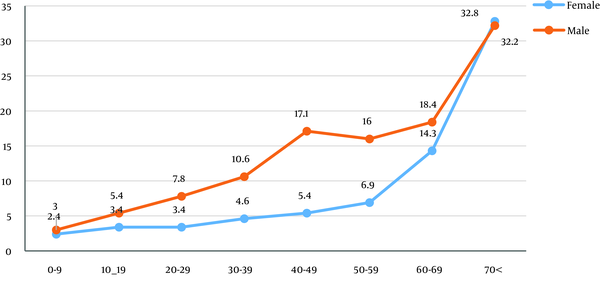Dear Editor,
The International Classification of Functioning, Disability, and Health (ICF) describes disability as an umbrella term for impairments, activity limitations, and participation restrictions. Disability is derived from the negative aspects of the interaction between individuals with a health condition (such as blindness, Down syndrome, cerebral palsy) and personal and environment determinants health organization. According to the 2010 global population estimates, 15% of the world’s population are living with a kind of disability. Of these, 2.2% have a severe disability so that they face outstanding limitations in activities of daily living (1).
Owing to the global increase in chronic health conditions related to disability and aging, the numbers of people with disabilities (PWDs) are increasing (2). Studies have highlighted that older people are exposed to a higher risk of disability and they have a higher prevalence of disability compared to younger age groups. In this paper, we intended to compare the prevalence of physical disability among different age groups in Iran. This retrospective study was a secondary analysis of existing data extracted from Statistical Center of Iran in 2011. Then we collected all data related to disability, according to the type of disability and its frequency. In the following, the prevalence of physical disability was calculated according to the number of persons with physical disability to the Iranian population in 2011.
The results revealed that the prevalence of physical disability tended to increase with age so that children aged 0 - 9 years had the lowest prevalence and older people aged 70 or over had the highest prevalence of physical disability. Of these, the males in all age groups except for 70 years and older had a higher prevalence of physical disability compared to the females. Figure 1 shows the prevalence of physical disability, according to age groups and gender in Iran in 2011. The findings in other countries indicated the older people have a higher prevalence of disability compared to the younger age groups. For example, in 2013, the results of the Behavioral Risk Factor Surveillance System (BRFSS) in the United States indicated that persons aged 65 and over had the highest prevalence of physical disability in comparison to the other age groups (3).
In Iran, we need internationally comparable data on disability. Unfortunately, there is a deep gap between the prevalence of physical disability in Iran with developed countries such as Canada, Germany, United States, and the UK (1, 3-6) This remarkable difference originates from various definitions of disability and different methods of data collection (7). Disability data in Iran probably is represented as a significant impairment or difficulty in the body function. Policymakers and stakeholders should formulate comprehensive policies to meet the health needs of people with physical disabilities (PWPDs). People with disabilities need more rehabilitation services, assistive devices, and long-term care in comparison to the general population; however, the services are not covered by many health insurances. The services usually are provided by the private health sector and PWPDs. The services impose much out of pocket payments and catastrophic costs on PWPDs and their families. The PWPDs face serious problems ranged from physical and financial access to rehabilitation and care services. The availability and acceptability of health care services should be evaluated by policymakers and researchers for PWPDs. Health insurances need to pay more attention to the needs of vulnerable people that their population is growing rapidly. Therefore, the needed healthcare for the growing population should be predicted by the health system. Obviously, response to all needs of PWPDs requires collaborative efforts and it involves all local and national actors and stakeholders. The study was funded by Kermanshah University of Medical Sciences.
